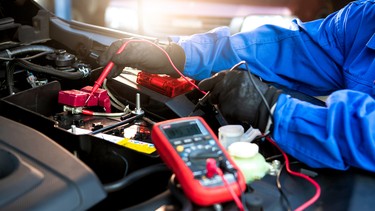Most original batteries can easily last through four or five Canadian winters, or sometimes even more

Article content
Of all the problems that can crop up on almost any type of motorized wheeled conveyance, battery failures rank near the top in the totally predictable and avoidable categories. This is because the overwhelming majority of main battery failures for traditional internal-combustion engines are easily foretold with a simple test.
Advertisement 2
Article content
A battery’s only job is to hold a reserve of electrical power and to deliver it on demand. While the basic technology in lead-acid batteries hasn’t changed much in the last century, their design and construction has advanced enough that most original batteries can easily last through four or five Canadian winters, or sometimes even more.
How can you get the most out of your vehicle’s battery?
Test batteries annually
While you might expect to do this just before winter hits, it’s really worth testing any time of year — after all, far more batteries fail from summer’s heat than from winter’s freeze. You can use a simple multi-meter to measure volts, but the real tale of a battery’s health is how it reacts to an electrical load. Most repair shops will include a battery load-test as a low- or no-cost offering when performing seasonal maintenance. Their testers will measure the voltage output of the battery by applying a load similar to what the starter draws when you turn the key.
Advertisement 3
Article content
-
![Gear Guide: Jump-starters, booster packs, trickle chargers, and battery chargers]()
Gear Guide: Jump-starters, booster packs, trickle chargers, and battery chargers
-
![Corner Wrench: 3 Alternatives to buying a new battery for an older vehicle]()
Corner Wrench: 3 Alternatives to buying a new battery for an older vehicle
Keep your engine bay clean
Engine bays, where most batteries live, are dirty places. Though most of that dust, grit, and grime doesn’t affect engine operation, it can degrade a battery. Get enough build-up on the top of a battery, and when things get damp, that layer can act as a high-resistance circuit from the positive to negative posts, eventually resulting in a drained battery.
Battery cables should never be allowed to grow a crusty build-up. This can restrict power flow, but a simple cleaning with a stiff wire brush is all it takes. Before removing any cables to clean their inner surface, however, check whether your radio has a security setting: if so, use a small 12 volt power supply (even something as simple as a tool battery) to temporarily keep the system powered and avoid locking up the radio.
Advertisement 4
Article content
Keep batteries tightly secured
Ever wonder why batteries are mounted so securely in the vehicle? Yes it’s to keep them from tipping over and potentially leaking corrosive battery acid, but it’s also to reduce vibrations. Lead-acid batteries’ internal plate welds are susceptible to damage from vibration and can crack, disrupting part of the circuit. If you regularly travel over rough roads or terrain, a periodic check of the battery’s hold-down and straps isn’t a bad idea.

Keep batteries thermally insulated
There’s a reason why many automakers are relocating batteries out of the engine bay and into areas such as inner fender wells, trunks, or even below the floor: to protect them from the scorch of under-hood heat. If your ride’s battery still lives under an expanse of hood sheet metal, you’re likely to get better performance out of it — along with a longer life — if you insulate it with a purpose-made battery blanket.
Advertisement 5
Article content
For heat protection, look for the thick textile type, not a plug-in electric wrap. That small added extra layer of insulation can make all the difference, and won’t cost much more than $20.
Use it or disconnect the battery
One major cause of early battery demise is simple lack of use. If your ride is parked for extended periods of time, a regular lead-acid battery will either need periodic charging or early replacement, as a battery in a low state of charge is more susceptible to cell damage when temperatures drop.
If your ride doesn’t have a radio or security system that needs resetting anytime the battery is off-line, consider installing an isolation switch to protect the battery. If your vehicle needs a constant source of electrical power, you can always get a controlled trickle charger. These units now come small enough to easily mount under the hood with the cord kept within handy reach, just like an engine’s block-heater cord.
Stay connected with us on social media platform for instant update click here to join our Twitter, & Facebook
We are now on Telegram. Click here to join our channel (@TechiUpdate) and stay updated with the latest Technology headlines.
For all the latest Automobiles News Click Here




Comments
Postmedia is committed to maintaining a lively but civil forum for discussion and encourage all readers to share their views on our articles. Comments may take up to an hour for moderation before appearing on the site. We ask you to keep your comments relevant and respectful. We have enabled email notifications—you will now receive an email if you receive a reply to your comment, there is an update to a comment thread you follow or if a user you follow comments. Visit our Community Guidelines for more information and details on how to adjust your email settings.
Join the Conversation